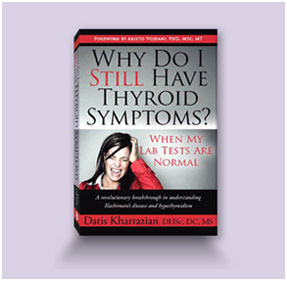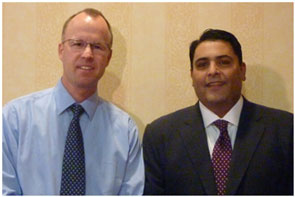Thyroid Dysfunction
While searching for better ways to help my patients, I was fortunate to learn of Dr. Datis Kharrazian, a pioneer in natural health care and author of the best selling book “Why do I Still Have Thyroid Symptoms When My Thyroid Tests Are Normal ?“. I have spent a great deal of time studying his work and in fact learning directly from him for quite some time now. On this page you will have the opportunity to learn of some fundamental aspects of thyroid function and dysfunction. I highly recommend reading Dr. Kharrazians book as well.
Introduction to Functional Thyroid Disorders
Functional thyroid disorders are incredibly common and often overlooked in our current healthcare model. Most patients that have functional thyroid imbalances do not have primary thyroid imbalances. In fact 5 out of every 6 thyroid patients are suffering from an undiagnosed auto-immune problem driving their thyroid problem.
Dr. Marquis’ Thyroid Lecture (50 Min.)
Thyroid problems are often misdiagnosed and mis-treated . . . and women are often affected the most. Over 80% of our patients who have a thyroid problem are not being treated in a manner that will provide them long term solutions and many are experiencing their problem worsen because the root cause has been overlooked.
See if this sound familiar? Your labs come back “Normal” and yet you still feel tired, achy, cold, depressed and mentally sluggish. I can’t tell you how many people have been told…”go home, get some rest, your blood work looks normal, you are probably just over worked.”
Or even worse, you are put on thyroid hormone replacement and you still have all the symptoms of hypothyroidism but your lab tests show that your thyroid levels are good. And worst of all it’s difficult to get anyone to listen to you. So now what do you do?
You go through your day with any one or more of these symptoms (some poor souls have them all!).

Book by Dr. Kharrazian
It doesn’t have to be that way. I have found that most patients will have inadequate labs (often only two tests done: TSH and T4) to determine if they have a thyroid problem. These two tests offer a simple screening for thyroid function but they certainly don’t provide the complete picture! Did you know there are over 20+ ways that your thyroid can go bad? Fundamentally there are 6 major categories for thyroid dysfunction and 24 subsets off of these 6. Only one of those ways will respond to typical replacement therapy. So why is everyone treated with hormone replacement if only 1 out of 6 will actually be resolved with the medication? Not everyone fits into the replacement model of treatment. Modern approaches allow us to determine your specific needs and then let the body correct itself with proper neurological and metabolic support.
Don’t go on feeling frustrated. We will always listen to your concerns and help you chart a course to get you back on track. You need Comprehensive Blood Work (see our Laboratory Analysis page) and Functional Neurological Analysis will help us determine the shortest path to getting you better. If you are ready to reserve an appointment please call. Below you will find some core information on thyroid and the physiology of the gland.
Thyroid Physiology Review
Once the thyroid is stimulated by Thyroid Stimulating Hormone (TSH) from the pituitary, it produces thyroxine (T4) and triiodothyronine (T3) by transporting iodine into the thyroid and by stimulating Thyroid Peroxidase Activity (TPO). TPO is involved in the formation of T4 and T3 as it catalyzes the oxidation of iodine using hydrogen peroxide. The thyroid will produce 94% of the available T4 and 7% of the available T3. As we know, T4 is inactive and T3 is an active thyroid hormone. Therefore, the majority of hormone production at the thyroid is inactive T4. Once the thyroid has produced T4, it is metabolized peripherally from the thyroid into combination T3 hormones by the enzyme 5′ deiodinase, mostly at the liver. Under normal circumstances, about 40% of the available T4 is converted into T3, 20% is converted into reverse T3 (rT3), which is irreversibly inactive, and 20% is converted into T3 sulfate (T3S) and triiodothyroacetic acid (T3AC). T3S and T3AC are inactive thyroid hormones until they circulate into the gastrointestinal tract and are acted upon by intestinal sulfatase into active T3. Gastrointestinal sulfatase activity is dependent upon a healthy gut microflora.
So with most of your thyroid hormone conversion occurring in the liver and gut what happens if your liver function is compromised or you have an inflamed gut. Do you know anyone with either or both of those problems? The funny thing is (and it's not really funny) that most people end up being told they have 3 distinct problems and never realize that their GI problems and toxic liver and Thyroid dysfunction are all part of the same disease. This is why so many people are suffering and being medicated but not finding resolution to their complaints. Looking at Thyroid dysfunction requires a comprehensive metabolic and neurological approach. In this way no stone is left unturned and although the process generally takes time patients do finally find the relief they have been seeking.
Understanding Thyroid Markers and Panels
TSH: Thyroid Stimulating Hormone (TSH) is also called thyrotropin. The pituitary releases this hormone after the hypothalamus releases TRH (thyrotropin-releasing-hormone). This is the most common marker used to assess thyroid function and it is also the most sensitive. The TSH levels increase when the T4 levels drop, and the TSH falls when T4 levels increase. This is the only test performed in the traditional health care model as a means to screen the patient for thyroid disorders; this is because they are only concerned for screening the thyroid for hormone replacement and not optimal physiological function. A TSH test alone does not consider thyroid pituitary feedback loops, peripheral thyroid metabolism, or potential or active risk factors as identified by antibody testing.
A high TSH with or without changes in T4 or T3 is diagnostic to determine hypothyroidism. If the thyroid is not making enough T4, the pituitary will pump out TSH to stimulate its production. A low TSH is used to determine hyperthyroid activity. If the thyroid is overactive such as in Grave’s disease, the antibodies bind to active thyrotropin(TSH) receptors on the thyroid cells and stimulate T4 production without the influence of TSH. Please note that some antibodies may inhibit thyroid function by inactivating instead of stimulating thyrotropin receptors. This is called an autoimmune hypothyroid. These patterns will demonstrate a hypothyroid pattern (elevated TSH) with elevated thyroid antibodies.
Laboratory Reference Range: 0.5 – 5.5 (varies from one lab to another)
Functional Reference Range: 1.5-3.5
Total Thyroxine (TT4): The TT4 test measures both bound and unbound thyroxine levels, therefore, it does not give the activity of T4 when measured alone. This test is best completed with a T3 uptake. The free thyroxine index (FT4) can be calculated by using the T3 uptake and demonstrating a level of T4 activity. Total T4 levels can be altered by many drugs.
Free Thyroxine Index: As stated earlier, the total thyroxine and T3 uptake must be used together to calculate the FT4. The index is measured by multiplying the TT4 levels by the T3 uptake levels. The result is the FT4 and it determines the amount of active T4 available. The impact of drugs, as will be discussed, will always impact T4 and resin T3 uptake levels in opposite directions due to its impact on binding sites. If the TT4 level is depressed, then the T3 uptake is high; if the TT4 is elevated, the resin uptake is low. Please note that even if you are taking drugs that may impact thyroid binding, the free thyroxine index should be within the normal range if your thyroid is functioning normally.
Free Thyroxine (FT4): The free thyroxine test is used to measure the amount of free or active T4 in the blood. All the factors such as drugs and physical conditions that may impact the TT4 do not impact the FT4. The level of T4 in the blood is high with hyperthyroidism or low with hypothyroidism. Please note that even a high TSH with normal T4 is enough to diagnose hypothyroidism. A rare pattern is an elevated T4 without hyperthyroidism, which may be related to a hereditary condition of thyroid resistance. Elevated Free T4 may also be caused by patients taking Heparin or by an acute illness that my briefly cause the binding protein levels to suddenly fall. If an illness becomes severe and chronic, it may decrease the FT4 levels but it is not a thyroid disease.
Resin T3 Uptake: The Resin T3 Uptake measures the amount of sites for active (unbound) T3 to bind on thyroxine-binding proteins. This test is performed by mixing the blood with radioactive thyroid hormones. These radioactive hormones then combine with binding sites on thyroxine-binding proteins. The blood is then exposed to a substance called a resin that will bind the unbound thyroid hormones, and measure for radioactivity. The result can be expressed as the percent of radioactivity found on the resin compared to the original radioactivity that was added. The more binding sites that are open on the proteins, the lower the resin-uptake result will be, and vice versa. For example, anything that reduces the binding sites, such as elevated testosterone or testosterone replacement therapy, causes a low T4 measurement because it leaves very few binding sites for any more thyroid hormone to bind to it. If T3 is added to the sample of the blood, little T3 will be bound. This pattern would have low TT4 levels and high Resin T3 Uptake levels. On the other hand, anything that raises the binding sites, such as estrogen or birth control pills, would cause a pattern of high TT4 and low T3 Uptake.
Free Triiodothyronine (FT3): This test measures the free T3 hormone levels. This test is rarely completed in traditional endocrinology. It is typically only used in a situation where the patient has hyperthyroid, yet the FT4 levels are normal. However, the FT3 test is the best marker to see what amount of active thyroid hormones is available for the thyroid receptor sites.
Reverse T3 or (rT3): This test measures the amount of reverse T3 that is produced. The production of rT3 typically takes place in cases of extreme stress such as major trauma, surgery, or severe chronic stress. It appears that the increased production of reverse T3 is due to inability to clear rT3, as well as from elevated cortisol.
Thyroid Antibodies: Thyroid auto-antibodies indicate that the body’s immune system is attacking itself. Production of thyroid auto-antibodies may create a hypothyroid or a hyperthyroid state. Some antibodies attach to the TSH receptors but do not cause a response. Therefore, the patient will complain of low thyroid symptoms, however the serum TSH may not be altered. It is just not able to cause a cellular change. On the other hand, some antibodies will bind to the receptor sites and cause over-activation of the thyroid. This will present as elevated T4 levels, a low TSH and elevated thyroid antibodies.

